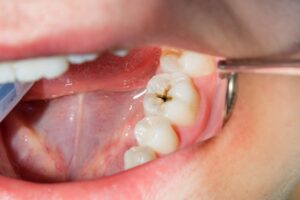
You may assume because of its low-maintenance convenience and discretion, Invisalign would protect you from getting cavities, too. Not true! Getting cavities during Invisalign treatment is absolutely possible, even as you wear your clear aligners for 22 hours a day. Read on to learn more about why cavities are possible, how to prevent them, and what to do if you’ve developed one!
How Cavities Form During Invisalign
Cavities develop when plaque, a sticky film of bacteria, builds up on the surface of your teeth. These bacteria feed on sugars in the food you eat, producing acids that gradually erode the tooth enamel. If left untreated, this decay can progress into deeper layers of the tooth, leading to more serious dental problems.
With Invisalign, aligners are worn for 20 to 22 hours a day, which means your teeth are covered for most of the day. This can create a snug environment where food particles and bacteria are trapped close to the enamel, especially if you don’t brush or floss properly. If aligners are placed back in after eating without cleaning your teeth, you’re essentially sealing in sugar and bacteria, creating the perfect conditions for cavities to form.
How to Prevent Cavities While Wearing Invisalign
Any time you eat or drink anything other than water, you should be taking your trays out. Before reinserting them, it’s best to:
- Brush your teeth for two minutes.
- Floss.
- Use an antibacterial mouthwash.
It is also important to practice this type of oral hygiene twice a day, regardless of if you just ate or not. Invisalign is removeable, so unlike traditional braces, there is no reason you can’t take care of your teeth properly!
Furthermore, you must clean your Invisalign trays as well. Brushing and soaking them with cleaners as recommended will help keep bacteria and food debris off of them, ensuring no cavities will form.
What to Do If You Get a Cavity During Treatment
Your dentist will need to place a filling or some other type of dental restoration to address the cavity issue. Some patients report soreness and discomfort when wearing their trays after a cavity has been filled. The fit of your aligners may feel off if you’ve had a larger restoration placed, like an inlay, onlay, or crown.
Cavities can form during Invisalign treatment just like during any other time, so it’s crucial that you’re taking good care of your teeth. Brush, floss, and use mouthwash daily, and always take your trays out before eating or drinking. Clean those aligners, too!
About the Author
Dr. Shabnam Tehrani earned her advanced Doctor of Dental Medicine degree at the University of Florida College of Dentistry and has consistently pursued ongoing education in several Tampa-area study clubs such as Spear and Pinnacle. If you’re interested in improving your smile and oral health with Invisalign, Dr. Tehrani and our team offer complimentary consultations to determine if you’re a good candidate for treatment. Schedule yours today through our website or call our Lutz office at (813) 751-3044.
